A Japanese puppet company plans to tour Iowa this summer. Photo: Matt Nelson
Writer: Emmett McMenamy
When disaster struck Japan almost 70 years ago, Iowans stepped up to help.
This act of altruism sparked an intercontinental friendship that has grown over time. And it all started with Iowa hogs.
In 1959 two typhoons swept through Yamanashi, a prefecture (like a state) west of Tokyo, and devastated its farms. Half a world away, the news reached a Pentagon staffer named Richard Thomas, who had grown up on an Iowa farm and been stationed with the U.S. Air Force in Yamanashi during World War II, just 15 years earlier. When he rallied Iowa farmers to help, they quickly loaded 36 hogs and thousands of bushels of corn on a plane and flew them across the ocean to Yamanashi. Within a decade, 500,000 hogs in Japan could trace their lineage to those three dozen Iowa hogs, according to the Iowa Farm Bureau.
As a measure of gratitude, the people of Yamanashi donated the Japanese Bell of Peace and Friendship that now hangs in a hilltop gazebo just west of the Iowa Judicial Branch Building near the state Capitol.
Iowa and Yamanashi became official sister states and have continued to support each other in times of crisis. When floods hit Iowa in 1993, for example, Yamanashi donated money to assist Iowa’s recovery. and when record-setting snow smothered Yamanashi in 2014, Iowa returned the favor.
The sister states share other things, too, including some of the best parts of their culture. The Japan America Society of Iowa (JASI) was founded in 1989 specifically to promote cross-cultural exchange. Its executive director, Yoko Tanaka, grew up in Japan, lives in Des Moines and can easily explain why she leads the group: “I’m simply sharing my excitement with American people.”
JASI’s recent and upcoming lineup of events here in Iowa reflects that excitement. This winter they hosted a sumo potluck and an annual sake party. In the next few months, they’ll host a touring puppet company from Japan and enlist Iowans to make 1,000 origami cranes to match a recent gift from Yamanashi. Plans are in the works to restore a historic Japanese teahouse that came to Des Moines in the 1940s.
In Yamanashi, locals have celebrated their own version of the Blue Ribbon Bacon Festival since 2017, a decade after it started in Des Moines. They also invited one Des Moines man to a high school baseball game, which you can read about below.
These cultural exchanges continue to enrich both sister states in big and small ways. When Japan’s Chicago-based consul-general Jun Yanagi visited Des Moines late last year for the sake party, he raised a toast to the sister states and the people who maintain their enduring friendship. “Thank you once again for the vital role each and every one of you has been playing in promoting the positive U.S.-Japan relationship.”
TEA TIME
During World War II, a woman named Tomoko Yamamoto lived in San Francisco and owned a traditional Japanese teahouse, the size of a garden shed. When the U.S. government started sending Japanese Americans to internment camps, she fled from California to Des Moines with help from an Iowan named Fae Huttenlocher and took the teahouse with her.
Since the structure was built without nails, it could be disassembled, boxed up and moved. But it was never rebuilt at her new home in Iowa. After Yamamoto and Huttenlocher died, years later, the teahouse materials were donated to the city of Des Moines and tucked away in storage, where they were mostly forgotten. When they were rediscovered in a warehouse during the floods of ’93, the city donated them to the Japan America Society of Iowa.
Today, the teahouse has been rebuilt inside JASI’s headquarters at the Franklin Events Center at 48th Street and Franklin Avenue. The group hopes to move it to a courtyard outside where the public can enjoy it, ideally in a new glass shelter. Ben Molloy, who is leading the relocation project, said that in Japan, traditional teahouses are used for relaxation, for notable events and even for bringing together warring parties for peace and reconciliation.
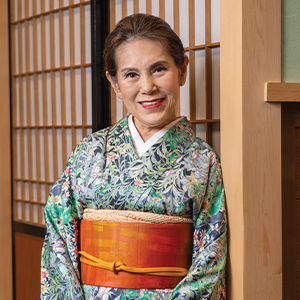 Yoko Tanaka, executive director of the Japan America Society of Iowa. Photo: Duane Tinkey
Yoko Tanaka, executive director of the Japan America Society of Iowa. Photo: Duane Tinkey
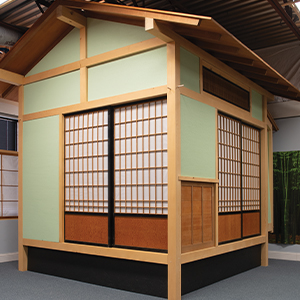
The Japan America Society of Iowa plans to move its historic teahouse to a more accessible spot outside the Franklin Events Center. Photo: Duane Tinkey
PUPPET MASTERS
Centuries ago in Japan’s shogun era, travelers between Kyoto and what is now Tokyo often stopped in Yamanashi overnight. Over the years, villages popped up along the Sasago River, where innkeepers and entertainers catered to the travelers. A tradition of puppet theater, called Bunraku, emerged more than 300 years ago and was passed down through generations to the present day, according to the Yamanashi tourism office.
A Bunraku company that maintains those traditions plans to tour Iowa this May. During their U.S. premiere, the eight members of the Sasago Oiwake Doll Preservation Association plan to perform in Cedar Rapids and at this year’s CelebrAsian festival, set for May 23-24 in Des Moines.
FRIENDLY FLOCK
In Japan, the paper-folding art known as origami is much more than a children’s pastime. “It’s not just a toy,” society director Tanaka said. “It’s culture itself.”
Tanaka first learned about origami as a girl in Tokyo and practiced techniques that had been passed down through generations. Now she wants to pass along the tradition to another generation here in Iowa. “If we can share one thing throughout Iowa, one thing that would unite people, I wanted that to be crane making,” she said.
When a group of Iowans recently visited Yamanashi, their hosts gave them 1,000 origami cranes. Now, Tanaka has invited Iowans to create another 1,000 cranes and hopes to display them together at the Iowa State Fair as a symbol of the sister states’ friendship. “It is uniting two cultures, as well as connecting through the communities in Iowa,” she said.
According to an old Japanese legend, anyone who folds 1,000 origami cranes will be granted a wish. The legend became famous in a 1977 book that told the true story of a girl named Sadako Sasaki, who was 12 when she developed leukemia from the radiation of the atomic bomb that landed on Hiroshima in 1945. She folded 644 before she died, in 1955, but the story of her determination lives on. After her family and friends completed her goal after her death, the cranes became a symbol of peace and goodwill.
BACON FESTIVAL
Brooks Reynolds never expected the Blue Ribbon Bacon Festival to turn into an international phenomenon. After all, the whole thing started by coincidence when he and some friends met up for a weekend and all happened to bring some bacon. That sparked an idea to establish the first official festival, in 2008, which eventually spun into popular iterations in Iceland and Japan.
“When I heard about the Iowa Hog Lift, I said, jokingly, ‘We should do a festival dedicated to bacon,’” he said. But one thing led to another, and in 2017 the first Yamanashi bacon festival drew about 5,000 visitors. And it just keeps growing.
“It’s quite popular,” said Kumi Nonaka, a restaurateur in Yamanashi who helps organize the annual springtime event. “Last year we had 25,000 people come.”
Reynolds has attended every bacon festival in Yamanashi and says it attracts lots of families, while the Iowa festival tends to draw an adult crowd. Both give people a chance to get together to share in what he called “food diplomacy.” As he put it, “We bring people together via food and share different flavor profiles that our different cultures have.”
At the Yamanashi festival, many locals volunteer as a way to express their gratitude for the now-famous hog lift back in 1959. And just like that original gift, samples of American bacon at the festival are free.
SAKE PARTY
Japan has a standard 40-hour workweek, but its workers are famous for putting in longer hours. “In Japanese business culture, people say that real business takes place after 5,” Tanaka said. “You go have a meal together, relax, and then honest conversation can take place.”
Often, that honest talk happens at an izakaya, a cozy pub on a quiet side street or alley. They’re often found in clusters, where each place serves sake (rice wine) and various local specialties — usually unpretentious comfort foods that change with the seasons.
For its annual sake party last fall, JASI re-created an izakaya at the River Center in downtown Des Moines, where guests mingled among stations filled with yakitori (grilled chicken skewers), tamago yaki (savory-sweet omelets), dango (chewy rice flour dumplings) and even a special sushi roll, custom-designed for the party. The event also featured an origami station, taiko drummers and a folk dance led by dancers from Des Moines and Cedar Rapids.
“If you’re feeling bold, you can join in,” announced David Yoshimura, who leads the JASI board. “And if you’re not feeling bold, the sake station is at the back.”
The annual party has become a popular tradition since JASI first hosted it in 2022, when leaders from Yamanashi sent a case of sake for a special toast.
Last fall, Yanagi, the consul-general, told the crowd that “sake holds a special place in our hearts.” He explained how it’s rooted in Japan’s climate, history, culture and everyday life. “For instance, enjoying sake while admiring cherry blossoms embodies the essence of Japanese spring.”

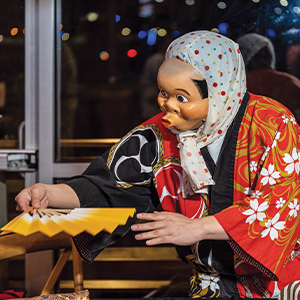
The Japan America Society of Iowa hosts an annual sake party, where guests sample different kinds of the fermented rice wine and often watch traditional performances, including costumed folk dances. Photos: Stephen Janousek
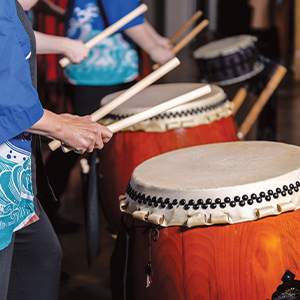
Taiko drummers pounded out complex rhythms at a sake party hosted by the Japan America Society of Iowa. Photo: Stephen Janousek
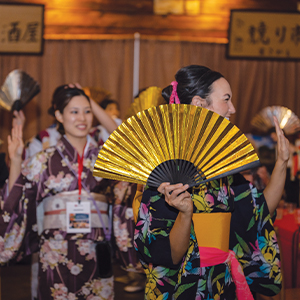
Dancers from Des Moines and Cedar Rapids led guests through a lively folk dance at JASI’s sake party last fall. Photo: Stephen Janousek
Michael Morain contributed reporting.
A day at the ballpark
In Japan, high school baseball is a big deal.
Writer and Photographer: Matt Nelson
“I’ve been looking forward to this game for weeks,” Hiro Hayano says. He grins like a schoolboy.
The sun is unusually strong for late October in Japan, and Hiro’s 4-year-old son, George, has a white hand towel draped over his head, like a little ghost. As a chorus of sharp pops ring out from the pregame warmups, Hiro is nothing short of entranced. But George is more interested in me and my potential as a living playground.
A high school game draws huge crowds to Hodogaya Stadium in Kanagawa, Japan.
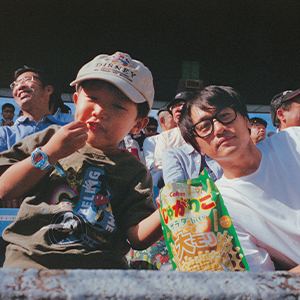
Young George and Hiro Hayano
It’s 9 a.m. on a Sunday here at Hodogaya Stadium, and baseball fans are already walking around the stands with cups of foamy beer. I’m a long way from home in Des Moines, but I can easily recall nights watching the Iowa Cubs at Principal Park (back when it was called Sec Taylor Stadium). The stands here in Kanagawa, south of Tokyo, are packed — not for a professional or even college game, but for a high school rivalry.
Hiro and hundreds of other fans arrived early this morning to get tickets and catch some of the pregame practice. He can tell me where each player is from, how old he is and how he excels on the field. We sit in the sun, behind the third base dugout, and the mood is light as the Yamanashi boys take an early lead.
“Do you ever recognize any of the players when you’re around town in Kofu?” I ask Hiro while George tries to slip a plastic cockroach down the back of my shirt.
“Yes, sometimes at the supermarket,” Hiro replies. “But I pretend not to notice and never say anything. It’s kind of embarrassing.” He grins.
Hiro grew up in a different prefecture, but he and his family live in Yamanashi, where his wife, Akimi, grew up. So he adopted the local team and follows them religiously. “Some of these players will go into professional baseball,” he tells me.
As we munch on ballpark fare — I bought hot dogs and churros outside the stadium — I notice a man nearby eating rice and meat with chopsticks out of Tupperware. Farther away, I see two two lively student sections, each with a band and cheerleading squad, and fans focused on the field. In Japan, high school baseball is as big as high school football in the United States.
I walk around the stadium to stretch my legs and take some pictures, and little George tags along. He’s attached to my hip or, to be more precise, he’s karate-chopping my hips and trying to kick but mercifully missing regions more vulnerable.
I first met Hiro in Des Moines in 2022, when he was visiting with a delegation from Yamanashi prefecture. Two years later he and Akimi, who’d studied in Des Moines for a semester, hosted a friend and me for a night at their home in Kofu.
After paying a visit to the student sections, I return to find George strapped comfortably back into his stroller. Yamanashi is still ahead but has been making errors left and right, which is highly uncommon, Hiro assures me. (The team hadn’t made a single error in the 17 preceding games). They rotate through their remaining pitchers as Kanagawa comes back and ties the game in the ninth inning. Hiro’s stomach is in knots.
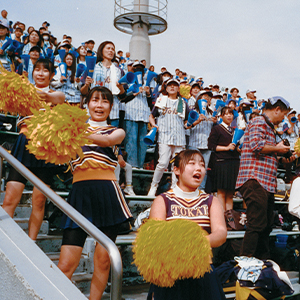 As the game stretches to extra innings, each team starts with two base runners, on first and second, to speed the game along. Yamanashi takes the field and brings in their sixth and final pitcher. Kanagawa uses a sacrifice bunt to advance the runners before Yamanashi walks the next batter (Kanagawa’s finest) to load the bases with only one out.
As the game stretches to extra innings, each team starts with two base runners, on first and second, to speed the game along. Yamanashi takes the field and brings in their sixth and final pitcher. Kanagawa uses a sacrifice bunt to advance the runners before Yamanashi walks the next batter (Kanagawa’s finest) to load the bases with only one out.
He keeps repeating himself: “I’m so nervous, man.” For him, a baseball field is almost a sacred space where time stops and everything else fades. A few weeks earlier, with his family in the mountains, I watched him take a practice swing with an invisible bat. With that look on his face, he could have been on another planet.
Yamanashi somehow squeaks through the inning while allowing just one run. The guys line up to bat with a vengeance. Still up against Kanagawa’s clearly fatigued starting pitcher — “their only good one,” Hiro tells me — Yamanashi’s batters send one line drive after another into the gaps to win the game. The crowd applauds, and Hiro gives me a big hug and a high five as the winning run crosses the plate. The team will advance to the next round of the national tournament.
After the game, Hiro takes us to a restaurant called Jonathan’s, which is essentially a Denny’s, except there are only about two visible staffers. We place our orders via a digital tablet at our table, a few minutes before a robot delivers our meal. I can’t decide if this has more to do with Japanese ingenuity or introversion, or maybe both.
The place is full with other fans from the game. The host gives us a token for the capsule-toy vending machine in the lobby, so George can get a free toy. The floors are sticky, but the food is great, like most places in Japan, including the big chains.
Hiro asks me about my work and travels, and I ask him about his life in Yamanashi. I think we’re both fascinated by each other’s life. He had traveled widely in his youth, met his wife while he was living in Australia and still travels with his family. They’re planning a trip to Korea next year and regularly visit Iowa to see friends.
He asks about my upcoming trip to India. I don’t know how long I’ll be there, but I tell him I hope to be in Japan for part of the spring. He seems interested in my nomadic life for the same reason I envy his stability. We’re at opposite ends of the spectrum. The grass seems greener …
Hiro grabs the bill, and we get ready to part ways.
“You should stay with us in Kofu when you’re back,” he offers. I hug him and George goodbye. I keep waving at George as he walks away backward, waving and smiling, holding his dad’s hand, and getting smaller with every step.













Show Comments (0)